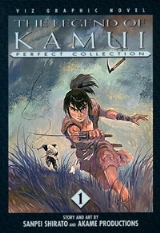
The Legend of Kamui
Encyclopedia
is a manga
by Sanpei Shirato
. Set in feudal Japan, it tells the story of a low-born ninja
who tries to flee his clan
. The series combines historical adventure
with social commentary
and themes of oppression and rebellion that reflect Shirato's Marxist convictions. It ran from December 1964 to July 1971 in the monthly gekiga
magazine Garo
.
In 1987 The Legend of Kamui became one of the first manga titles to be published in the United States (by Viz Comics). The Viz edition featured lettering and retouching by Usagi Yojimbo
creator Stan Sakai
.
(1969), and a film, Kamui Gaiden (2009).
Manga
Manga is the Japanese word for "comics" and consists of comics and print cartoons . In the West, the term "manga" has been appropriated to refer specifically to comics created in Japan, or by Japanese authors, in the Japanese language and conforming to the style developed in Japan in the late 19th...
by Sanpei Shirato
Sanpei Shirato
, known by the pen name , is a Japanese manga artist and essayist known for his social criticism as well as his realistic drawing style and the characters in his scenarios. He is considered a pioneer of gekiga. The son of the Japanese proletarian painter Toki Okamoto, his dream to become an artist...
. Set in feudal Japan, it tells the story of a low-born ninja
Ninja
A or was a covert agent or mercenary of feudal Japan specializing in unorthodox arts of war. The functions of the ninja included espionage, sabotage, infiltration, and assassination, as well as open combat in certain situations...
who tries to flee his clan
Clan
A clan is a group of people united by actual or perceived kinship and descent. Even if lineage details are unknown, clan members may be organized around a founding member or apical ancestor. The kinship-based bonds may be symbolical, whereby the clan shares a "stipulated" common ancestor that is a...
. The series combines historical adventure
Adventure
An adventure is defined as an exciting or unusual experience; it may also be a bold, usually risky undertaking, with an uncertain outcome. The term is often used to refer to activities with some potential for physical danger, such as skydiving, mountain climbing and or participating in extreme sports...
with social commentary
Social commentary
Social commentary is the act of rebelling against an individual, or a group of people by rhetorical means, or commentary on social issues or society...
and themes of oppression and rebellion that reflect Shirato's Marxist convictions. It ran from December 1964 to July 1971 in the monthly gekiga
Gekiga
is Japanese for "dramatic pictures." The term was coined by Yoshihiro Tatsumi and adopted by other more serious Japanese cartoonists who did not want their trade to be known as manga or "irresponsible pictures." It's akin to Will Eisner who started calling his comics "graphic novels" as opposed...
magazine Garo
Garo (magazine)
was a monthly manga anthology magazine in Japan, founded in 1964 by Katsuichi Nagai. It specialized in alternative and avant-garde manga.-History:...
.
In 1987 The Legend of Kamui became one of the first manga titles to be published in the United States (by Viz Comics). The Viz edition featured lettering and retouching by Usagi Yojimbo
Usagi Yojimbo
is a comic book series created by Stan Sakai in 1987. In 2011 IGN ranked Miyamoto Usagi 92nd in the top 100 comic books heroes.-Concept:Set primarily at the beginning of Edo period of Japan , with anthropomorphic animals replacing humans, the series features a rabbit ronin, Miyamoto Usagi, whom...
creator Stan Sakai
Stan Sakai
is a third-generation Japanese American Cartoonist comic book creator. He is best known as the creator of the comic series Usagi Yojimbo. -Biography:...
.
Related works
The original series became the basis for several spinoffs and continuations, including the manga Kamui Gaiden (1965–1967) and Kamuiden Dai 2 Bu (1982–1986). It also inspired an animated television series, Kamui the NinjaKamui the Ninja
is a shōnen anime produced by Tele-Cartoon Japan in 1969. It was broadcast in Japan from 6 April 1969 to 28 September 1969 by Fuji TV. Kamui the Ninja had 26 episodes with a running time of 22 minutes each one. The series was based on the manga The Legend of Kamui by Sanpei Shirato.-Plot:Kamui is a...
(1969), and a film, Kamui Gaiden (2009).

